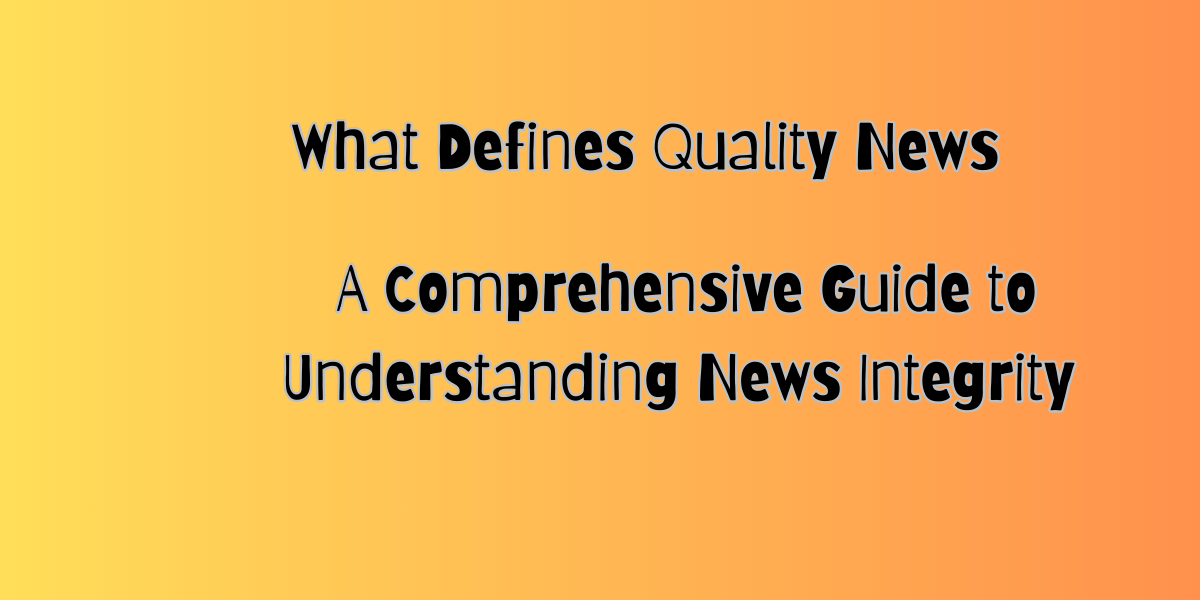In an age where information is abundant and opinions are diverse, the concept of quality news is more important than ever. With countless news outlets competing for attention, consumers are often left wondering how to differentiate between credible, well-researched stories and those that prioritize sensationalism or clickbait. So, what defines quality news? Is it simply the accuracy of the information, or does it encompass something deeper, like impartiality, context, and the credibility of the sources?
This article explores the essential factors that What Defines Quality News in today’s fast-paced media landscape, offering insights into the core principles that distinguish reliable journalism from the noise. We will delve into aspects like factual accuracy, transparency, fairness, and the evolving role of media in shaping public perception. By understanding these defining features, readers can make more informed decisions about the news they consume.
What is Quality News?
Quality news is defined by several key elements that ensure the information is not only accurate but also relevant, balanced, and responsible. While the internet has democratized information dissemination, it has also led to the rise of misinformation, bias, and sensational reporting. As such, identifying quality news becomes a necessary skill for consumers in the digital age.
1. Accuracy and Factual Integrity
At its core, quality news is based on facts. Accuracy is non-negotiable in journalism. Every claim, quote, and statistic should be verified, and sources should be credible. False or misleading information can cause significant harm, from undermining public trust to influencing elections or inciting violence.
To maintain accuracy, journalists rely on reputable sources, cross-check information, and clarify potential ambiguities. Fact-checking organizations like Snopes and PolitiFact also play a key role in ensuring that news remains truthful.
2. Transparency of Sources
Transparency is another cornerstone of quality news. This refers to both the clarity of the information provided and the openness of the journalists about their sources. A quality news outlet discloses its sources clearly, allowing readers to assess the reliability of the information. This transparency also extends to corrections: when errors occur, they should be openly addressed, not hidden.
Journalists and news organizations should provide context for how they gathered their information, especially in cases where the information may be incomplete or contested. The credibility of a news outlet is often tied to how open it is about the origins of its stories.
3. Objectivity and Fairness
Quality news should aim to be impartial. This does not mean that every piece of journalism must be devoid of opinions, but rather that news should present information in a balanced way. This includes covering multiple viewpoints and ensuring that one perspective does not dominate the story without a fair counterpoint.
In addition, journalists should strive to avoid biases, whether intentional or unconscious. This is particularly important in politically charged stories or when discussing divisive topics. A well-rounded presentation of the facts enables the reader to form their own informed opinion rather than being spoon-fed one-sided narratives.
4. Context and Depth
The best news is not just about the headlines; it provides readers with context and depth. Contextualizing stories helps readers understand the broader implications of an event or issue, which is critical for an informed public. This involves explaining the historical, cultural, or social background of a story, and how it connects to larger trends or ongoing discussions.
In-depth reporting often goes beyond surface-level facts and dives into the complexities of an issue. This approach is vital in avoiding oversimplification and misrepresentation, providing readers with a fuller understanding of a topic.
5. Accountability and Ethical Standards
Quality journalism adheres to strict ethical standards. This includes avoiding plagiarism, not manipulating images or quotes, and ensuring that reporting does not harm individuals or groups. Ethical journalism also respects privacy and strives to minimize harm while reporting on sensitive topics.
Furthermore, credible news outlets hold themselves accountable for the stories they publish. They issue corrections when necessary and take responsibility for errors, demonstrating their commitment to journalistic integrity.
6. Independence and Autonomy
Finally, a defining characteristic of quality news is its independence. News organizations must be free from external influence, whether that’s from advertisers, government entities, or corporate interests. Independent journalism is less likely to be swayed by agendas that compromise the quality of the information presented. A free press is vital to a functioning democracy, providing citizens with the information needed to make informed decisions.
The Rise of Misinformation and Its Impact on Quality News
In the digital age, misinformation has proliferated across social media platforms and even within traditional media. While the spread of false or misleading information is not a new phenomenon, the speed at which it circulates today is unprecedented. This is why discerning quality news from misinformation has become a crucial skill for modern consumers.
The Role of Social Media
Platforms like Twitter, Facebook, and TikTok have become primary sources of news for many people. However, these platforms also enable the rapid spread of misinformation, often amplifying sensational headlines over accurate reporting. In many cases, algorithms prioritize content that engages users, even if it’s misleading, inflammatory, or misleading.
Combating Misinformation
To counter the effects of misinformation, readers should cross-check news with multiple trusted sources and utilize fact-checking websites. Moreover, quality news outlets have adopted strategies to combat false narratives, such as including fact-checking elements in their reporting or publishing explanations of how certain stories are verified.
What Defines Quality News? A Comparison
Here’s a helpful comparison chart summarizing the key traits of quality news and how they contrast with lesser standards:
| Aspect | Quality News | Sensational/Low-Quality News |
| Accuracy | Facts are rigorously verified and double-checked. | Often based on rumors or unverified sources. |
| Transparency | Sources are clearly disclosed and transparent. | Lack of clarity about sources or methodology. |
| Objectivity | Balanced and impartial coverage of all viewpoints. | Biased towards a specific agenda or viewpoint. |
| Context | Provides context, background, and analysis. | Focuses solely on sensationalism or headlines. |
| Ethics | Adheres to journalistic ethics and accountability. | May engage in misleading tactics, such as clickbait. |
| Independence | Free from external influence or bias. | Can be influenced by advertisers, politics, or other interests. |
How to Identify Quality News
For readers, identifying quality news involves critical thinking and a systematic approach:
- Check the Source: Always consider the reputation of the outlet providing the news. Established outlets with a history of integrity are more likely to produce quality news.
- Examine Multiple Sources: Cross-referencing multiple news sources can help identify discrepancies and verify the accuracy of a story.
- Be Aware of Clickbait: Headlines designed solely to grab attention may lead to misleading or exaggerated stories. Be skeptical of such headlines.
- Look for Expert Opinion: Quality news stories often feature expert commentary and provide deeper insights from professionals in the field.
- Fact-check: Use independent fact-checking websites to verify the claims in a story.
Conclusion
In an era of constant media consumption, the ability to recognize what defines quality news is vital for staying informed. Accurate, balanced, and ethical journalism is more essential than ever, especially in an age where misinformation and bias are rampant. By focusing on the key elements of transparency, factual accuracy, objectivity, and ethical reporting, readers can ensure they are consuming information that is not only true but also reliable. With these tools in hand, the public can better navigate the news landscape, making informed decisions in a rapidly changing world.











